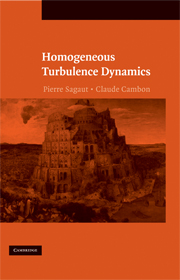Book contents
- Frontmatter
- Contents
- Abbreviations Used in This Book
- 1 Introduction
- 2 Statistical Analysis of Homogeneous Turbulent Flows: Reminders
- 3 Incompressible Homogeneous Isotropic Turbulence
- 4 Incompressible Homogeneous Anisotropic Turbulence: Pure Rotation
- 5 Incompressible Homogeneous Anisotropic Turbulence: Strain
- 6 Incompressible Homogeneous Anisotropic Turbulence: Pure Shear
- 7 Incompressible Homogeneous Anisotropic Turbulence: Buoyancy and Stable Stratification
- 8 Coupled Effects: Rotation, Stratification, Strain, and Shear
- 9 Compressible Homogeneous Isotropic Turbulence
- 10 Compressible Homogeneous Anisotropic Turbulence
- 11 Isotropic Turbulence–Shock Interaction
- 12 Linear Interaction Approximation for Shock–Perturbation Interaction
- 13 Linear Theories. From Rapid Distortion Theory to WKB Variants
- 14 Anisotropic Nonlinear Triadic Closures
- 15 Conclusions and Perspectives
- Bibliography
- Index
10 - Compressible Homogeneous Anisotropic Turbulence
- Frontmatter
- Contents
- Abbreviations Used in This Book
- 1 Introduction
- 2 Statistical Analysis of Homogeneous Turbulent Flows: Reminders
- 3 Incompressible Homogeneous Isotropic Turbulence
- 4 Incompressible Homogeneous Anisotropic Turbulence: Pure Rotation
- 5 Incompressible Homogeneous Anisotropic Turbulence: Strain
- 6 Incompressible Homogeneous Anisotropic Turbulence: Pure Shear
- 7 Incompressible Homogeneous Anisotropic Turbulence: Buoyancy and Stable Stratification
- 8 Coupled Effects: Rotation, Stratification, Strain, and Shear
- 9 Compressible Homogeneous Isotropic Turbulence
- 10 Compressible Homogeneous Anisotropic Turbulence
- 11 Isotropic Turbulence–Shock Interaction
- 12 Linear Interaction Approximation for Shock–Perturbation Interaction
- 13 Linear Theories. From Rapid Distortion Theory to WKB Variants
- 14 Anisotropic Nonlinear Triadic Closures
- 15 Conclusions and Perspectives
- Bibliography
- Index
Summary
Effects of Compressibility in Free-Shear Flows. Observations
To understand and model compressibility-induced effects on turbulence is an important topic, as these effects are significant in many engineering applications, particularly in the fields of propulsion and supersonic aerodynamics, which are concerned with jets or wakes subjected to large velocity and density gradients. The compressible plane mixing layer is a generic problem for these applications, and explaining and modeling how compressibility reduces turbulent mixing in a shear layer has motivated the large research effort devoted to this topic during the 1980s and 1990s. Mixing usually refers to interpenetration of two streams. It is characterized by two scales: a length scale δ and a velocity scale ΔU, which evaluate the thickness of the interface and intensity of the fluctuations, respectively. The reduction of mixing by compressibility is illustrated in Fig. 10.1 in which δ is the previously mentioned thickness and Mc = ΔU/a is the convective Mach number, with a the average speed of sound.
There is now a consensus in the literature that the “intrinsic compressibility” (nonzero-velocity divergence in Mach-number-dependent flows) of a turbulent velocity field tends to reduce the amplification rate of turbulent kinetic energy produced by mean-velocity gradients, with respect to the solenoidal case.
- Type
- Chapter
- Information
- Homogeneous Turbulence Dynamics , pp. 327 - 357Publisher: Cambridge University PressPrint publication year: 2008



